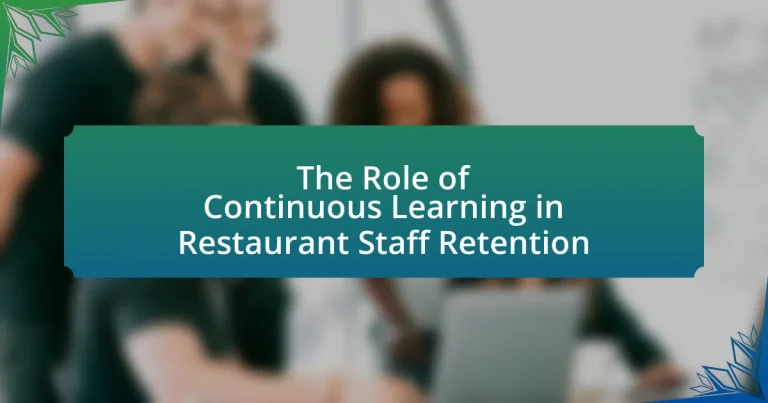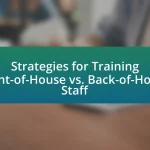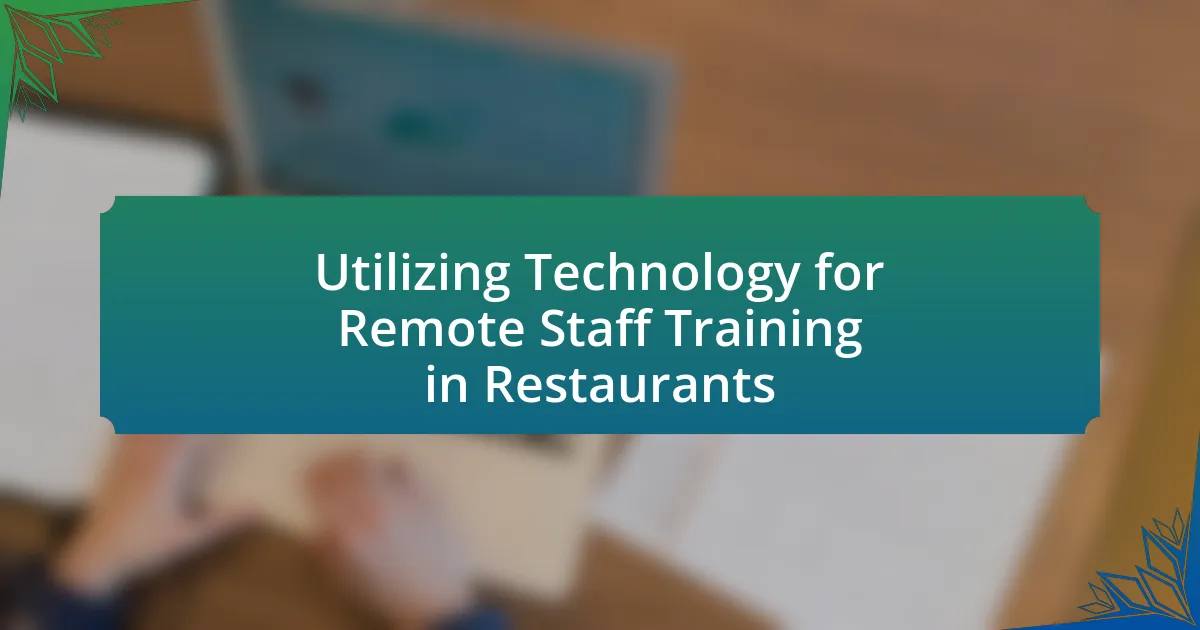The article focuses on the critical role of continuous learning in enhancing restaurant staff retention. It highlights how ongoing training and development improve employee skills, job satisfaction, and overall engagement, leading to lower turnover rates and increased profitability for restaurants. Key aspects discussed include the impact of continuous learning on employee satisfaction, specific learning opportunities that contribute to job satisfaction, and the challenges restaurants face in implementing effective learning programs. Additionally, the article outlines best practices for fostering a culture of continuous learning, the importance of mentorship, and methods for measuring the effectiveness of learning initiatives in the restaurant industry.
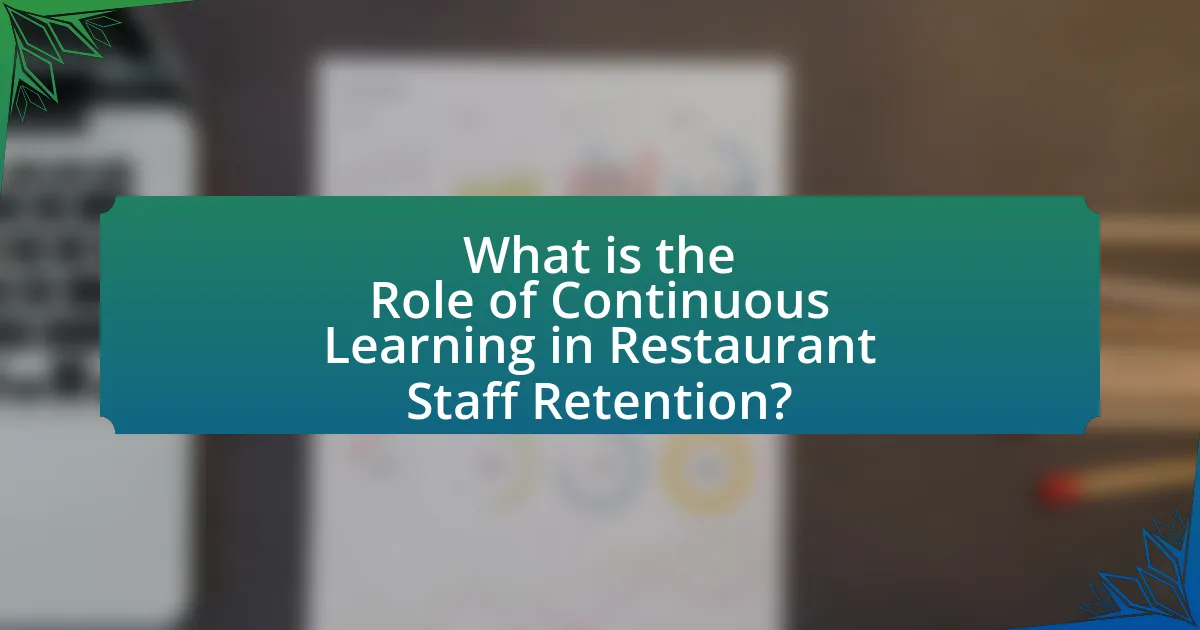
What is the Role of Continuous Learning in Restaurant Staff Retention?
Continuous learning plays a crucial role in restaurant staff retention by enhancing employee skills and job satisfaction. When restaurant staff engage in ongoing training and development, they feel more competent and valued, which directly correlates with their commitment to the organization. Research indicates that companies investing in employee development experience a 24% higher profit margin and a 218% higher income per employee, demonstrating the financial benefits of retaining skilled staff. Furthermore, continuous learning fosters a positive work environment, reducing turnover rates and associated hiring costs.
How does continuous learning impact employee satisfaction in restaurants?
Continuous learning significantly enhances employee satisfaction in restaurants by fostering skill development and career advancement opportunities. When restaurant staff engage in ongoing training, they feel more competent and confident in their roles, which directly correlates with higher job satisfaction levels. Research indicates that organizations prioritizing continuous learning report a 34% increase in employee engagement, as employees perceive their employers as invested in their growth. This investment leads to a more motivated workforce, reducing turnover rates and improving overall morale within the restaurant environment.
What specific learning opportunities contribute to job satisfaction?
Specific learning opportunities that contribute to job satisfaction include training programs, mentorship, and skill development workshops. Training programs enhance employees’ competencies, leading to increased confidence and job performance, which are directly linked to job satisfaction. Mentorship provides guidance and support, fostering a sense of belonging and career growth. Skill development workshops allow employees to acquire new abilities relevant to their roles, making them feel valued and engaged. Research indicates that organizations investing in employee development see a 24% increase in job satisfaction, highlighting the importance of continuous learning in enhancing workplace morale and retention.
How does employee satisfaction influence retention rates?
Employee satisfaction significantly influences retention rates by fostering a positive work environment that encourages employees to remain with the organization. When employees feel valued and satisfied with their roles, they are less likely to seek employment elsewhere; studies show that organizations with high employee satisfaction can experience turnover rates up to 50% lower than those with low satisfaction levels. This correlation is supported by research from the Society for Human Resource Management, which indicates that satisfied employees are more engaged, productive, and committed to their employers, ultimately leading to higher retention rates.
Why is continuous learning essential for restaurant staff?
Continuous learning is essential for restaurant staff because it enhances skills, improves service quality, and increases employee retention. In the fast-paced restaurant industry, staff must adapt to new culinary trends, customer preferences, and technology advancements. For instance, a study by the National Restaurant Association found that 70% of employees who receive ongoing training feel more engaged and are less likely to leave their jobs. This engagement directly correlates with improved customer satisfaction and operational efficiency, making continuous learning a critical component for success in the restaurant sector.
What skills can be developed through continuous learning?
Continuous learning can develop skills such as adaptability, problem-solving, communication, and technical proficiency. Adaptability is crucial in the fast-paced restaurant environment, allowing staff to adjust to new procedures or menu changes effectively. Problem-solving skills enhance employees’ ability to address customer complaints and operational challenges efficiently. Communication skills improve teamwork and customer interactions, fostering a positive dining experience. Technical proficiency, including familiarity with new technologies and software, increases operational efficiency and service quality. Research indicates that organizations prioritizing continuous learning see a 37% higher employee retention rate, underscoring the importance of skill development in retaining restaurant staff.
How does skill development affect employee performance?
Skill development significantly enhances employee performance by equipping individuals with the necessary competencies to execute their tasks effectively. When employees engage in skill development programs, they become more proficient in their roles, leading to increased productivity and efficiency. Research indicates that organizations investing in employee training see a 24% higher profit margin compared to those that do not prioritize skill development. Furthermore, skilled employees are more likely to innovate and contribute to problem-solving, which directly impacts overall organizational performance.
What challenges do restaurants face in implementing continuous learning?
Restaurants face several challenges in implementing continuous learning, primarily due to high employee turnover rates, limited resources, and varying levels of staff engagement. High turnover, which can exceed 70% annually in the restaurant industry, disrupts the continuity of training and learning initiatives, making it difficult to establish a culture of continuous improvement. Limited resources, including time and budget constraints, hinder the ability to provide comprehensive training programs. Additionally, varying levels of staff engagement can lead to inconsistent participation in learning opportunities, as not all employees may prioritize or value continuous learning. These factors collectively impede the effective implementation of continuous learning strategies in restaurants.
What are common barriers to continuous learning in the restaurant industry?
Common barriers to continuous learning in the restaurant industry include high employee turnover, time constraints, and limited access to training resources. High turnover rates, which can exceed 70% annually in some establishments, disrupt the continuity of learning and make it challenging to implement long-term training programs. Time constraints arise from the fast-paced nature of restaurant work, leaving little opportunity for staff to engage in learning activities during shifts. Additionally, many restaurants lack the financial resources to invest in comprehensive training programs, further hindering continuous learning efforts.
How can restaurants overcome these challenges?
Restaurants can overcome challenges related to staff retention by implementing continuous learning programs that enhance employee skills and job satisfaction. By providing ongoing training and development opportunities, restaurants can foster a culture of growth, which has been shown to increase employee engagement and reduce turnover rates. For instance, a study by the National Restaurant Association found that establishments offering training programs experience 50% lower turnover compared to those that do not. This approach not only equips staff with necessary skills but also demonstrates the restaurant’s commitment to their professional development, ultimately leading to improved retention.

How does continuous learning contribute to a positive workplace culture?
Continuous learning fosters a positive workplace culture by enhancing employee engagement and promoting collaboration. When employees participate in ongoing training and development, they feel valued and invested in, which increases their motivation and job satisfaction. Research from the Association for Talent Development indicates that organizations with strong learning cultures experience 30-50% higher employee engagement levels. This engagement leads to improved teamwork and communication, as employees are more likely to share knowledge and support one another in a learning-oriented environment. Furthermore, continuous learning helps to reduce turnover rates, as employees are more likely to remain with organizations that prioritize their professional growth.
What role does continuous learning play in team dynamics?
Continuous learning enhances team dynamics by fostering collaboration, improving communication, and increasing adaptability among team members. When team members engage in continuous learning, they develop new skills and knowledge that contribute to a shared understanding of tasks and goals. This shared knowledge base encourages open communication, as individuals feel more confident in discussing ideas and challenges. Furthermore, teams that prioritize continuous learning are better equipped to adapt to changes in the restaurant industry, such as new technologies or customer preferences, leading to improved performance and retention rates. Research indicates that organizations that invest in employee development experience higher levels of engagement and lower turnover, reinforcing the importance of continuous learning in maintaining effective team dynamics.
How can learning initiatives foster collaboration among staff?
Learning initiatives foster collaboration among staff by creating shared experiences and knowledge, which enhance teamwork and communication. When employees participate in training programs together, they develop a common understanding of processes and goals, leading to improved cooperation. Research indicates that organizations with strong learning cultures see a 30% increase in collaboration among teams, as employees feel more connected and engaged with their colleagues. This collaborative environment not only boosts morale but also contributes to higher retention rates, as staff members are more likely to stay in workplaces where they feel supported and valued through continuous learning opportunities.
What impact does a collaborative environment have on retention?
A collaborative environment significantly enhances employee retention by fostering a sense of belonging and teamwork. Research indicates that organizations with high levels of collaboration experience a 50% lower turnover rate compared to those with less collaborative cultures. This is because collaborative environments promote open communication, shared goals, and mutual support, which increase job satisfaction and employee engagement. Furthermore, a study published in the Journal of Applied Psychology found that employees who feel connected to their colleagues are 67% more likely to stay with their employer long-term.
How does continuous learning enhance career advancement opportunities?
Continuous learning enhances career advancement opportunities by equipping individuals with updated skills and knowledge relevant to their field. In the restaurant industry, for example, staff who engage in continuous learning can adapt to new culinary trends, customer service techniques, and technology, making them more valuable to employers. Research indicates that organizations that promote continuous learning see a 37% higher employee retention rate, as employees feel more competent and engaged in their roles. This increased competence often leads to promotions and leadership opportunities, as employers recognize the value of skilled and knowledgeable staff.
What pathways for advancement can be created through learning?
Learning creates pathways for advancement such as skill enhancement, career progression, and leadership opportunities. Skill enhancement through training programs enables restaurant staff to improve their culinary, customer service, and management skills, which can lead to promotions. Career progression is facilitated by structured learning paths that align with organizational goals, allowing employees to move into higher roles, such as from line cook to sous chef. Leadership opportunities arise when staff engage in learning initiatives that prepare them for supervisory positions, fostering a culture of growth and retention. According to a study by the National Restaurant Association, 70% of employees reported that training and development opportunities significantly influenced their decision to stay with their employer, highlighting the importance of continuous learning in staff retention.
How does career growth influence employee loyalty?
Career growth significantly enhances employee loyalty by providing individuals with a clear pathway for advancement and skill development. When employees perceive opportunities for promotion and professional development, they are more likely to feel valued and invested in their organization. Research indicates that companies offering career development programs experience a 34% increase in employee retention rates, demonstrating a direct correlation between growth opportunities and loyalty. This relationship is particularly evident in the restaurant industry, where continuous learning initiatives can lead to higher job satisfaction and commitment among staff.
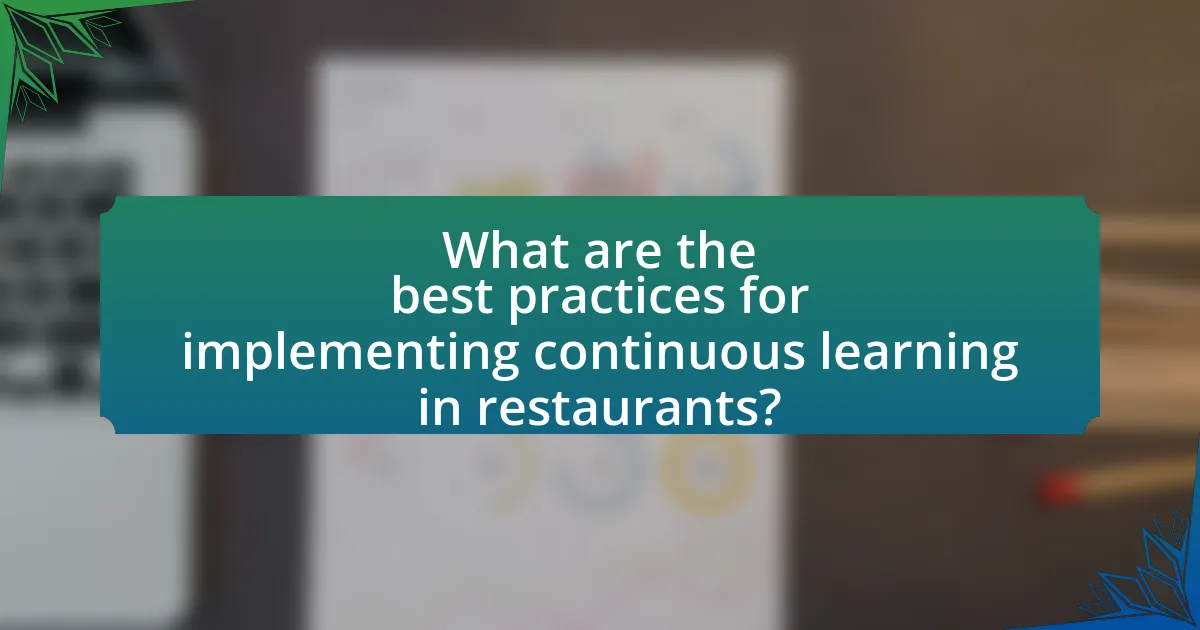
What are the best practices for implementing continuous learning in restaurants?
The best practices for implementing continuous learning in restaurants include establishing a structured training program, fostering a culture of feedback, and utilizing technology for learning resources. A structured training program ensures that all staff receive consistent and comprehensive training, which can lead to improved performance and job satisfaction. Fostering a culture of feedback encourages open communication and allows employees to learn from their experiences, enhancing their skills and engagement. Utilizing technology, such as online training modules and mobile learning apps, provides flexible access to learning materials, accommodating different learning styles and schedules. Research indicates that restaurants with effective training programs experience lower turnover rates, highlighting the importance of continuous learning in staff retention.
What types of training programs are most effective for restaurant staff?
On-the-job training, customer service training, and food safety training programs are the most effective for restaurant staff. On-the-job training allows employees to learn in a real-world environment, enhancing their skills through practical experience. Customer service training focuses on improving interaction with patrons, which is crucial for customer satisfaction and retention. Food safety training ensures compliance with health regulations and promotes a safe dining experience, reducing liability for the restaurant. Research indicates that restaurants with comprehensive training programs experience lower turnover rates, as employees feel more competent and valued in their roles.
How can on-the-job training be integrated with formal learning?
On-the-job training can be integrated with formal learning by creating a structured program that combines practical experience with theoretical knowledge. This integration can be achieved through mentorship programs where experienced staff guide new employees while simultaneously providing access to formal training materials, such as online courses or workshops. Research indicates that organizations that blend these approaches see a 20% increase in employee retention rates, as employees feel more competent and engaged in their roles. Additionally, aligning on-the-job tasks with formal learning objectives ensures that employees can immediately apply what they learn, reinforcing their skills and knowledge in real-time.
What role do mentorship programs play in continuous learning?
Mentorship programs play a crucial role in continuous learning by facilitating knowledge transfer and skill development among participants. These programs pair less experienced individuals with seasoned professionals, creating an environment where mentees can gain insights, receive feedback, and develop competencies relevant to their roles. Research indicates that organizations with mentorship initiatives report higher employee engagement and retention rates, as mentorship fosters a culture of learning and support. For instance, a study by the Association for Talent Development found that 75% of executives believe mentoring is critical for career development, highlighting its significance in promoting ongoing education and professional growth within the workplace.
How can restaurants measure the effectiveness of their learning initiatives?
Restaurants can measure the effectiveness of their learning initiatives through employee performance metrics, customer satisfaction scores, and retention rates. By analyzing performance metrics such as sales figures, service speed, and error rates before and after training, restaurants can quantify improvements in staff capabilities. Additionally, customer satisfaction scores, often gathered through surveys, can indicate how well staff apply their training in real-world scenarios. Retention rates serve as a long-term measure; a decrease in turnover after implementing learning initiatives suggests that employees find value in the training provided. These methods collectively provide a comprehensive view of the impact of learning initiatives on both staff performance and overall business success.
What metrics should be used to assess employee development?
Key metrics to assess employee development include employee performance evaluations, training completion rates, skill acquisition assessments, employee engagement scores, and retention rates. Employee performance evaluations provide insights into individual contributions and areas for improvement, while training completion rates indicate the effectiveness of learning programs. Skill acquisition assessments measure the specific competencies gained through training, and employee engagement scores reflect overall satisfaction and commitment to the organization. Retention rates serve as a critical indicator of the success of development initiatives, as higher retention often correlates with effective employee development strategies.
How can feedback be utilized to improve learning programs?
Feedback can be utilized to improve learning programs by systematically collecting and analyzing input from participants to identify strengths and weaknesses in the curriculum. This process allows program developers to make data-driven adjustments that enhance the effectiveness of training. For instance, a study by Hattie and Timperley (2007) in “Review of Educational Research” highlights that feedback significantly influences learning outcomes, showing that targeted feedback can lead to a 20% increase in performance. By implementing structured feedback mechanisms, such as surveys or focus groups, learning programs can be continuously refined to better meet the needs of restaurant staff, ultimately contributing to higher retention rates.
What practical steps can restaurant managers take to promote continuous learning?
Restaurant managers can promote continuous learning by implementing structured training programs, encouraging mentorship, and providing access to online learning resources. Structured training programs, such as onboarding and ongoing skill development sessions, ensure that staff are consistently updated on best practices and new techniques, which can lead to improved performance and job satisfaction. Mentorship initiatives pair experienced employees with newer staff, fostering a culture of knowledge sharing and support. Additionally, providing access to online learning platforms allows employees to pursue courses at their own pace, enhancing their skills and engagement. Research indicates that organizations that invest in employee development experience higher retention rates, as employees feel valued and empowered in their roles.
